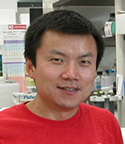Recently, we’ve been profiling first authors of Plant Cell papers that are selected for In Brief summaries. Here are the first-author profiles from the May issue of The Plant Cell.
Xunliang Liu, featured first author of The role of LORELEI in pollen tube reception at the interface of the synergid cell and pollen tube requires the modified eight-cysteine motif and the receptor-like kinase FERONIA
Current Position: Postdoctoral Research Associate in the Palanivelu Lab, School of Plant Sciences, The University of Arizona.
Education: PhD: Plant Biology, Institute of Plant Physiology and Ecology, Shanghai, China.
Non-scientific Interests: Reading, hiking, Chinese chess, and table tennis.
I was born in a small village in northwest Zhejiang province, China. My grandfather loved gardening. When I was a child, his garden was my playground, and his enthusiasm cultivated my interest in plants. I started to get interested in the biology of plants in high school. After graduation, I joined the College of Agriculture and Biotechnology in Zhejiang University to study plant science, and afterwards I joined the Institute of Plant Physiology and Ecology in Shanghai to pursue a doctoral degree in plant biology. During my Ph.D. studies, I developed an interest in understanding how plant cells sense environmental changes and how they coordinate their responses to these signals. When I was finishing up my Ph.D. program, I read a paper written by Dr. Kessler and Dr. Grossniklaus entitled “She’s the boss: signaling in pollen tube reception”, and was fascinated by the beauty of this system for studying cell-cell communication. Luckily, I got the opportunity to join Dr. Ravi Palanivelu’s lab to study the function of LORELEI protein in pollen tube reception. In this project, by expressing and delivering LORELEI in the pollen tube, we demonstrated that LORELEI has a FERONIA-dependent function at the interface of the synergid cell and pollen tube during pollen tube reception.
Xianfeng Ma, featured first author of Dual and opposing roles of xanthine dehydrogenase in defense-associated reactive oxygen species metabolism in Arabidopsis
Current Position: Research Associate in the Institute for Bioscience and Biotechnology Research (IBBR), University of Maryland.
Education: PhD in Plant Science, Hunan Agricultural University, Changsha, China.
Non-scientific Interests: Running, Travelling, Cooking, and Reading.
In 2008, I received a PhD scholarship from Hunan Agricultural University to conduct two years of research in Dr. Shunyuan Xiao’s lab at the University of Maryland. During this period, I gained knowledge and skills in plant pathology and molecular biology, and identified XANTHINE DEHYDROGENASE 1 (XDH1) in Arabidopsis thaliana to be functionally connected to plant defense through a typical forward genetics approach. Thanks to Dr. Xiao’s appreciation of my work, I came back to work on the RPW8-XDH1 project as a postdoc in 2013. Just like everyone else in his lab, I am intrigued by the exquisite mechanisms of RPW8.2-mediated resistance: it is specifically targeted to the host-pathogen interface where it somehow activates H2O2 production to restrict fungal haustoria. I was very excited by my observation that loss of XDH1 impairs haustorium-focused H2O2 production as it implies a functional link between RPW8.2 and XDH1. However, functional characterization of XDH1 turned out to be very challenging. It took me three years to resolve the identity of the autofluorescent object (AFO) formed in the XDH1-null plants and figure out how XDH1 performs two opposing roles in producing H2O2 in epidermal cells to fight against pathogens while removing H2O2 from stressed chloroplasts to protect mesophyll cells from oxidative damages. I would like to thank all my colleagues and collaborators for making this project a success and I hope to continue the exciting research towards understanding and exploiting molecular mechanisms of plant disease resistance.
Ying Wang and Jie Qu, profiled co-first authors of A land plant-specific transcription factor directly enhances transcription of a pathogenic noncoding RNA template by DNA-dependent RNA Polymerase II
Ying Wang
Current Position: Research Scientist at Department of Molecular Genetics, The Ohio State University, U.S.A.
Education: PhD (2010) in Plant Cellular & Molecular Biology at The Ohio State University, U.S.A.; B.S. (2004) in Life Sciences at Wuhan University, P.R.China.
Non-scientific Interests: Traveling, cooking.
I grew up on the campus of Wuhan University in central China. My family strongly supports my education and career development. When working on my PhD degree in Dr. Biao Ding’s lab at The Ohio State University, I became fascinated with the worlds of RNA. In particular, I am dedicated to exploring plant interactions with Potato spindle tuber viroid (PSTVd) as well as the evolution and function of regulatory non-coding RNAs in plants. In this collaborative study, we revealed the first eukaryotic transcription factor that directly enhances RNA-dependent RNA polymerase activity of DNA-dependent RNA polymerase II. We dedicate this work to the memory of our beloved mentor, colleague, and friend, Dr. Biao Ding (1960-2015). I would like to continue exploring the worlds of RNA using the PSTVd model, which was also a dream of Dr. Ding’s.
Jie Qu
Current Position: Postdoctoral Researcher in the Center for Applied Plant Sciences and the Department of Molecular Genetics at The Ohio State University, U.S.A.
Education: PhD (2013) in Horticulture and Crop Science at The Ohio State University, U.S.A.; B.S. (2007) in Biotechnology at Shanghai Jiao Tong University, P.R.China.
Non-scientific Interests: Singing, cooking.
I grew up in Jingzhou, along Yangtze River in central China. When I was in middle school biology class, I was amazed by the diversity and complexity of life, from small viruses to multicellular organisms such as plants. When I came to America to pursue my interest in plant biology, I began to look beyond exciting phenomena, and learned to address fundamental questions leading to the understanding of underlying molecular mechanisms. After joining Dr. Biao Ding’s lab, I was fascinated by the small “naked” infectious RNA, Potato spindle tuber viroid (PSTVd), which does not encode any protein and has to use plant cellular machineries for its own replication and spreading. In particular, I’m interested in studying how host plant proteins can interact with PSTVd and facilitate its replication, which is described in this collaborative work. The learned knowledge can help us better understand RNA biology. On the other hand, it also provides great potential to fight against this pathogenic RNA that causes devastating loss of crop plants, such as tomatoes and potatoes.
